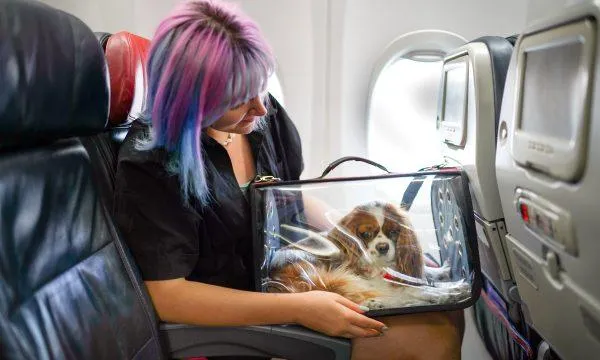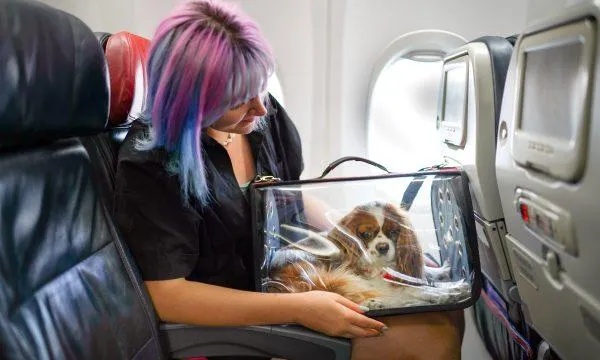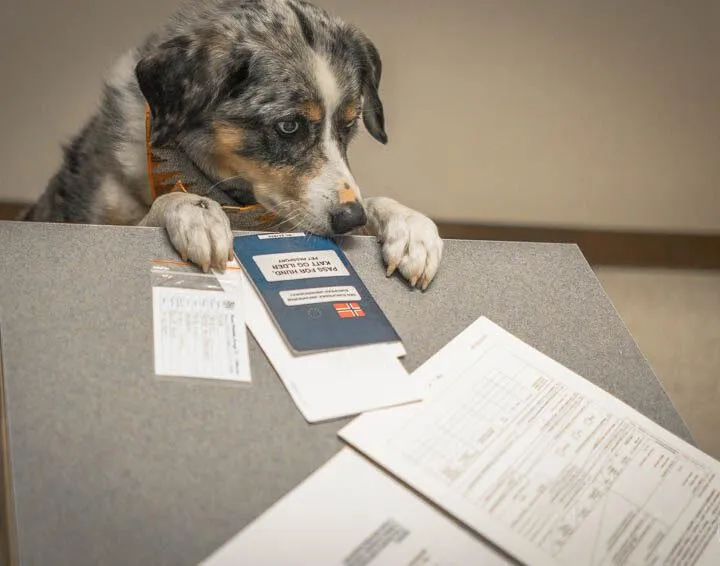A Comprehensive Guide to Booking Air Travel for Your Canine Companion
Whether you’re planning a family vacation, a business trip, or need to relocate to a new city, there’s a good chance you want to bring your loyal pup along for the journey. However, booking plane tickets for dogs comes with its own set of considerations. In this article, I’ll cover everything you need to know to safely fly with your furry friend.
Check Airline Pet Policies
The first step is determining which airlines allow traveling with pets in the cabin or cargo hold. Policies vary significantly between carriers. Most major airlines permit small dogs to fly in-cabin in their carrier under the seat, while larger dogs must travel in the freight area. Always check baggage size limits and fees too. From my experience, it’s best to contact the airline directly to clarify any pet travel restrictions.
Select a Pet-Friendly Carrier
Per federal rules, your dog must be kept in an FAA-approved hard-sided carrier labeled “Live Animal” that fits completely under the seat. The carrier should be large enough for them to stand up, turn around, and lie down comfortably. I recommend trying it out at home first to ensure your pup is okay confined for long periods. Leaves and pads can line the bottom. Remember to bring food, water, and toys too.
Book Well in Advance
Plan ahead at least a month for booking pet tickets, especially during busy seasons. Seats for dogs are limited on each flight. You typically can’t simply show up to the airport with Fido expecting a spot. Plus, it gives time to ensure vaccines are up to date. I’ve definitely faced situations where last-minute bookings weren’t possible due to lack of availability.
Confirm Health Documents
All dogs must have updated vaccinations and health certificates from your vet. Requirements vary internationally, so research destination regulations. The documents usually need to be dated within 10 days of travel. Some carriers may also require an exam within hours of check-in. Double check all paperwork meets airline standards to avoid issues at the airport. A single error can ruin your travel plans.

Watch Feeding Schedule
I advise skipping food for at least six hours before a flight to reduce risk of motion sickness, but don’t let your pup get too hungry either. Use your judgment based on previous car rides. Bring small snacks and sippy cups of water for in-flight if needed. Have easy-to-carry meals ready upon arrival too since appetites vary after stress. The last thing anybody wants is an upset stomach mid-flight!
Consider Sedation from the Vet
Some dogs handle travel anxiety much better than others. If your pooch gets very distressed, discuss medication options with your vet. A light sedative may help them relax, especially for longer flights. However, sedatives aren’t right for every dog either. Know your pet and trust your vet’s guidance. With the proper precautions, travel can still be a positive experience for dogs with some extra care.
Prepare Identification
A standard must is your pup’s up-to-date ID tag on their collar along with a contact phone number inside the carrier. Additionally, make copies of licenses, vaccination records, and microchip information and store them separate from the originals. This basically covers you in case anything gets lost. Even for chilled out dogs, stress and excitement can cause them to slip collars on occasion. Better safe than sorry!
Pack Comfort Items
Personal scents, toys, and treats packed discreetly near your dog can work wonders soothing anxiety at unfamiliar airports and aboard planes with strange noises. Keep high-value chews and bully sticks to occupy anxious mouths safely. A worn piece of your clothing can also provide needed familiarity and calm nerves. Dogs gain confidence from small comforts when facing big changes.
Prepare for Climate Changes
Seasonal shifts can be an added challenge for dogs not used to cold or hot weather. Consider packing extra sweater layers, booties, or cooling vests depending on destination weather. Speak with your vet about preventative measures to ease any change and protect paws. Simple steps like gradual exposure during walks go a long way to making the transition smoother in new climates.

Practice Airport Routines
Before the big day, rehearse what your dog can expect step-by-step from the car, through security checkpoints, onto the plane, and back again. Get them used to being calmly constrained and not pulling or jumping on arrival. Practice crate/carrier training at home for longer durations too. By sort of kind of mimicking the real experience beforehand, you ease potential stress.
Be Prepared for Delays
Sometimes strong winds or mechanical issues cause planes to sit on the tarmac longer than expected, which isn’t ideal with a dog aboard. Bring supplies like extra pee pee pads and food in your carry-on to make waits more comfortable. Communicate any travel disruptions promptly to those picking you up too. With some patience and the right planning, even hiccups won’t ruin your vacation plans completely. Hopefully!
Fly Non-Stop When Possible
Minimizing connections eases stress on dogs that struggle staying crated for too long. However, sometimes it just isn’t realistic depending on destinations. In those cases, give yourself ample time between flights as a buffer in case of delays. Know that multi-leg journeys will likely tire pets out more so come prepared for extra resting. Hiking before flights also pooches pooped for the ride.
Consider Boarding over Layovers
If a connection forces your doggo to linger crated at an airport past comfort levels, see if approved day cares or kennels in the area board during extended layovers instead. It gets them a chance to stretch, relieve, and recharge. Just be sure facilities are legit, clean, and pet-friendly. For important trips, amenities like this are worth paying for when it eases animal stress significantly.
Get Comfortable during Flight
Once aboard, keep your carrier buckled securely under the seat in front of you within reach. Speak calmly and cheerfully to your pup when flight attendants permit. Let them see you relaxed to stay calm too. Bring along favorite blankets or toys for in-cabin fun. I’ve found that giving Kong toys stuffed with peanut butter or canned food works like a charm to distract anxious fliers. Just don’t go overboard with treats!

In closing, with the proper planning and paperwork, most dogs can travel by air without major issues. Remember that each fur baby is an individual too, so adjust accordingly based on their needs and personality. The key is minimizing stress every step of the way. From vaccine schedules to carriers, comfort items, and handling delays – all the details matter. Safe travels to you and your pup! Let me know if any other pet travel questions come up.
Considerations for Flying with Your Dog
| Requirement | Details |
|---|---|
| Carrier | Check specific requirements for size/breed restrictions and health certifications needed by the airline. |
| Cabin or Cargo | Most carriers only allow small/medium dogs in-cabin, others require all pets fly in cargo. |
| Crate | The FAA requires dogs be transported in a soft- or hard-sided crate that fits under the seat. |
| Health Certificate | Most international flights require a certificate issued within 10 days of travel by a licensed vet. |
| Sedation | Consult your vet about whether sedation is appropriate and safe for your dog during flight. |
FAQ
-
Can I bring my dog on the plane as a carry-on?
Generally, you cannot bring your dog into the main cabin as a carry-on. Some smaller dogs may fit in a carrier under the seat, but most airlines only allow service animals in the cabin. You’ll need to check your dog as cargo.
-
How early should I arrive at the airport with my dog?
It’s a good idea to get to the airport at least 2 hours before your flight if traveling with a dog. You’ll need extra time to check-in the dog, get their carrier inspected and possibly go through additional screening. Depending on how busy the airport is, it could take awhile. Better safe than sorry!
-
What paperwork do I need for my dog’s airline ticket?
Most airlines require a health certificate, proof of vaccinations and an animal travel bag or crate meeting their size requirements. The paperwork must be shown at check-in and often needs to be dated within 10 days of your return flight. Check with your specific airline for all their pet transportation policies and paperwork rules.
-
How much does a dog airline ticket usually cost?
Dog ticket prices can vary greatly depending on the airline, size of your pet, and destination. But on average, you can expect to pay around $150 – $300 per direction for a dog ticket in the cargo hold as an additional fee on top of your own plane ticket. Obviously bigger dogs in larger kennels may cost more.

-
Is it safe to fly with a dog in cargo?
While flying pets in cargo means they’re separated from you in the plane’s belly, statistics show the vast majority of animals fly without incident. However, it’s not without risk. Some experts say animals don’t always get the same timely care in an emergency either. At the end of the day, you must decide if the stress is worth getting your pet to their destination. Most vets agree flying is low risk if proper precautions are taken.
-
Can I sit next to my dog on the plane?
Unfortunately, you cannot accompany your pet in the cargo area below deck for their safety and security. By regulation, all pets must travel in kennels or carriers in cargo. However, some airlines like Delta offer a “petSafe” program where employees will monitor your dog in cargo and let you know how they’re doing with photo updates at certain points of the journey. Perhaps someday you’ll see a doggie daycare area under the plane!
-
What size kennel do I need for my dog?
The kennel or pet carrier used must be large enough for your dog to stand up, turn around and lie down comfortably. Most airlines have specific size limits listed on their websites. Measure your dog from the tip of their nose to the base of their tail then add 4-6 inches to determine the appropriate carrier size. Kennels that are too big or small can cause issues and delays, so be sure to follow guidelines carefully.
